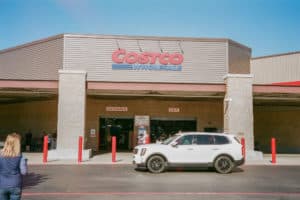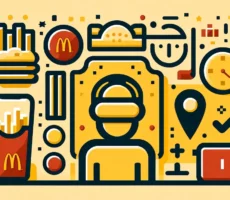Ever felt like navigating through a corporate decision-making process is like trying to decode alien hieroglyphs? Well, you’re not alone.
This post is your flashlight in the complex hallways of managerial choices, specifically how a retail giant like Costco makes its decisions that steer the colossal business ship.
Quick Takeaways:
- Costco leverages data analytics and values employee feedback to proactively address business challenges and refine their storefront operations.
- Decision-making at Costco is a team sport with a decentralized approach that empowers managers at all levels, aligning with their overall strategies emphasizing customer and employee satisfaction.
- The company’s use of advanced tools like business intelligence software and predictive analytics, coupled with meticulous outcome measurement, keeps their operations both strategic and responsive.
How Does Costco Identify Business Challenges?
When it comes to spotting the hurdles in their path, you can bet your bottom dollar that the folks at Costco aren’t just shooting in the dark. This retail giant leans heavily on data analytics and market research to pinpoint problems before they snowball into bigger issues. They sift through mountains of sales data, customer feedback, and market trends to identify areas that might need a little TLC or a complete overhaul.
One unique angle Costco has is its member-based model, which offers a goldmine of transactional and behavioral data. By analyzing purchase patterns and customer interactions, the company can identify shifts in consumer behavior or satisfaction levels. It’s not just about what’s flying off the shelves, but also about understanding why things are gathering dust.
In addition, Costco’s management doesn’t turn a blind eye to front-line employees. Store staff often have their ears to the ground and can provide invaluable insights that might not pop out in quantitative data. By integrating this feedback with their analytical findings, Costco ensures it’s not just counting numbers but reading between the lines to tackle challenges head-on.
Who Calls the Shots at Costco?
At Costco, decision-making isn’t a one-person show. It’s more of a team effort, with a clear pecking order that ensures everyone sings from the same hymn sheet. From store managers who ensure the day-to-day operations are smooth as silk, to corporate executives who steer the ship through uncharted waters, each level has its own role to play.
Let’s start on the ground. Store managers are the captains of their own ships. They make tactical decisions that keep customers happy and shelves stocked. Climbing up the ladder, district and regional managers come into play, acting as crucial links between individual stores and the higher-ups.
When it comes to the bigger picture, executive members, including the President, CEO, and various Vice Presidents, step up to the plate. They look at strategic decisions that impact the company’s path forward, from financial strategies to potential new markets.
But here’s the kicker: unlike some corporate goliaths where the top dogs call all the shots, Costco values a more decentralized approach. Store managers have considerable leverage in tailoring their operations to the local market. This autonomy allows for quick, nimble decisions that resonate with the local customer base, a little nugget of wisdom that keeps Costco a cut above the rest.
What Strategies Guide Costco’s Decisions?
When the rubber meets the road, Costco’s decision-making is guided by a few north stars that keep them cruising along successfully. First and foremost, customer satisfaction is king. I mean, let’s face it, without happy members, Costco wouldn’t have such an enviable business model. They focus on delivering value, which translates to quality products at prices that are tough to beat.
Next up is cost-efficiency, but not at the expense of quality. Costco is a poster child for keeping things lean and mean. They boast a limited selection of merchandise compared to traditional supermarkets, which may seem counterintuitive. But this strategy cuts down on excess inventory and helps bulk buying—which, in turn, keeps prices down.
Here’s an interesting tidbit: sustainability isn’t merely a buzzword at Costco; it’s woven into their decision fabric. We’re talking long-term sustainability in environmental practices, but also in building enduring relationships with suppliers, communities, and of course, members.
What’s the unique sauce in Costco’s strategy pantry, you ask? It’s their unwavering commitment to employee satisfaction. Happy employees lead to happy customers—it’s a simple recipe. Costco offers higher wages and better benefits than many of their retail rivals, which results in lower employee turnover and a dedicated workforce. This investment in their staff is a testament to their belief that a strong team is the backbone of solid decision-making.
And so, as we pull back the curtain on Costco’s managerial decision-making, one thing is clear: this is a company that knows its strengths and plays to them wisely, all while keeping a keen eye on the horizon for the next opportunity or challenge.
How Does Costco Involve Its Employees in Decision-Making?
At Costco, the belief is that frontline employees are the backbone of the company – and that’s not just lip service. They’ve woven this philosophy into the very fabric of their decision-making process. Employee involvement is a hallmark of Costco’s culture, and here’s how it breathes life into their operations:
- Bottom-Up Feedback Loop: When you walk the aisles of any Costco warehouse, know that the employees you see restocking shelves or assisting customers could very well be the source of the company’s next big decision. An idea that starts on the storefront can escalate to the managerial level through a structured, yet open, feedback system.
- The Suggestion Box That Matters: Costco doesn’t just have a suggestion box that collects dust in the break room. Suggestions from employees can reach all the way up the executive ladder. This isn’t a rare occurrence either; it happens more often than you’d think!
- Ownership and Responsibility: Employees are encouraged to own their space, understanding that their voices will be heard and can lead to tangible changes in their work environment or company policy.
For instance, let’s say there’s an employee who notices that a particular product isn’t selling as well as expected. By voicing this observation, they might set off a chain reaction that leads to a strategic pricing adjustment or a change in how the product is displayed. That’s the kind of input that not only fosters a sense of involvement and responsibility among the workforce but also keeps the business nimble and responsive to market conditions.
What Tools and Technologies Support Costco’s Decision-Making?
In today’s retail world, flying by the seat of your pants just won’t cut it. Costco is acutely aware of this, which is why they’ve harnessed cutting-edge tools and technologies that underpin their decision-making process. Here’s a peek into their tech toolbox:
- Business Intelligence Software: To stay ahead of the curve, Costco invests in robust business intelligence platforms like SAP and Tableau. These tools help them wade through vast oceans of data, delivering insights that might otherwise slip through the cracks.
- Inventory Management Systems: These are pivotal in helping Costco keep just the right amount of stock. Too much, and you’re wasting space and resources; too little, and you’re missing out on sales. Their systems strike that delicate balance with ninja-like precision.
- Predictive Analytics: By analyzing past shopping trends and customer behavior, Costco can make educated guesses about the future. It’s like having a crystal ball, but instead of mystical powers, it’s powered by algorithms and machine learning.
Here’s an insider scoop: Costco doesn’t just crunch numbers; they’re savvy about “social listening” as well. Monitoring social media channels for customer feedback and trending topics directly informs product selection, promotions, and in-store experiences, often driving decisions before they reach traditional datasets.
How Does Costco Measure the Outcomes of Its Decisions?
Closing the loop on the decision-making process, Costco is big on measuring outcomes. They know that to keep the ship sailing smoothly, they need to understand the impact of every choice they make. Here’s how they do it:
- Sales Figures and Inventory Turnover: It’s the bread and butter of retail metrics. If a decision is spot-on, you’ll see it reflected in robust sales and a healthy inventory turnover rate.
- Customer Satisfaction Surveys: Costco checks the pulse of their members’ happiness through regular surveys. They’ve got a keen ear to the ground and listen closely to what the feedback is telling them.
- Employee Retention Statistics: They believe that happy employees lead to happy customers. So, they carefully monitor turnover rates and take them as a key measure of management’s performance.
An example that really drives this home is Costco’s decision a few years back to raise its minimum wage well above the national average. They tracked the outcome and found a meaningful uptick in employee retention and satisfaction, which, yes, led to more efficient operations and happier customers – talk about a win-win!
Through their continuous improvement lens, each of these metrics feeds back into the decision-making process, helping Costco stay nimble, responsive, and, quite importantly, in sync with their employees, members, and the market.





